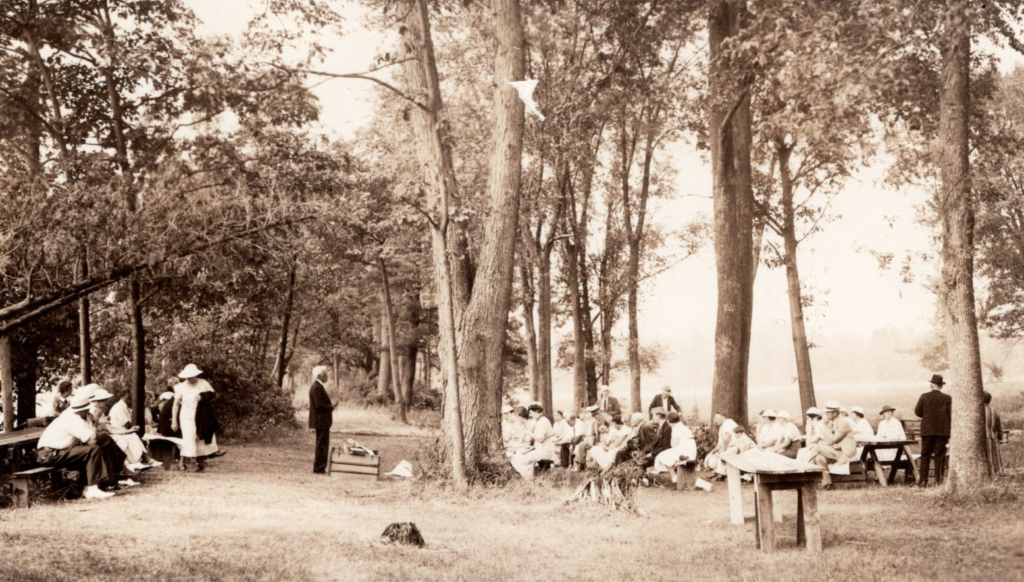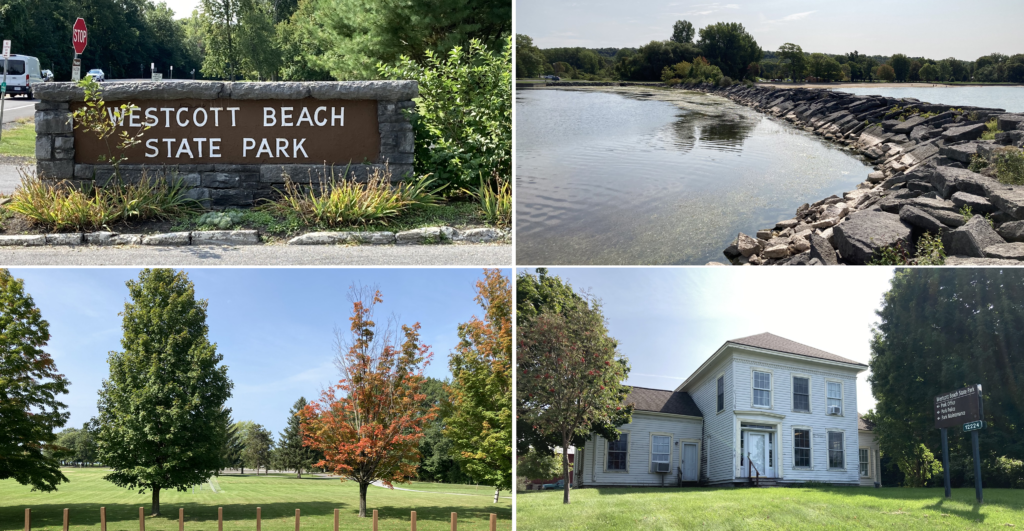
“The third annual reunion and picnic of Northern New York Chapter was held at Westcott Beach near Sackets Harbor, N.Y., on Monday, August 10, [1936] the home of Mr. and Mrs. George H. Westcott. Despite a heavy thunderstorm in the forenoon, sixty-eight were present. Through the generous hospitality of our host and hostess, their spacious farm home was thrown open for the luncheon. During luncheon, the storm ceased, the sun came out brightly, and all adjourned to the beach” (from a report by Mrs. Lulu Westcott Burgen in the September 1936 Westcott Family Quarterly).

In 1946, the Westcott family sold 170 acres of their farm south of Sackets Harbor to the State of New York. Westcott Beach State Park, opened in 1950, includes a 3,000-foot beach, picnic groves and playing fields (lower left), and 164 campsites. A jetty (upper right) reaching out into Henderson Bay divides the beach front into a bathing area and a boat launch. The original Westcott homestead (lower right), a 12-room house overlooking the grove and beach, now serves as park headquarters.
Heading to the North Country
So, how did our Westcott kin end up populating northern New York and owning a 3,000 foot beach just right for family gatherings? The short answer comes in a report in the September 1934 Westcott Family Quarterly about their second annual reunion titled “Up North Westcotts Organize”:
Seventy of the Westcott kindred of northern New York, including ten members of our national Society, assembled at Westcott Beach, near Sackets Harbor, N.Y., on August 27th, to “know their kindred better.”
The Westcotts of northern New York descend chiefly from Gardiner and Mary (Knight) Westcott, natives of Rhode Island, who after living a short time at Cheshire, Mass., settled at Deerfield (now North Utica, N.Y.) about 1793. Ten years later, with the majority of his eleven children, Gardiner removed to near Sackets Harbor where he died in 1808. He had over seventy grandchildren. When the English attacked Sackets Harbor in 1813, Celeb Westcott, son of Gardiner, almost singlehanded, held the invaders back until the American troops could arrive. A colonel of the troops was John Westcott, another son. The Westcotts therefore, are justified in the pride they hold in their beautiful and glorious north-country.
The following offers a few more details about the aforementioned Gardiner, Caleb and George Westcott. Click here to see more genealogical information from our archive and from genealogist Tina Thorp at the Sackets Harbor Historical Society.
Gardiner Westcott (1744-1808)
Gardiner Westcott, a fifth generation descendant of Stukely and Juliana Westcott, was born on September 1, 1744 in Kingston, R.I., the third child and first son of Caleb Westcott and Hannah Gardiner (see Caleb Westcott, Skilled Carpenter). In 1764 he married Mary Knight of the Knightsvillle section of Cranston, R.I. and ran a small farm next to his in-laws.
Sometime after the Revolutionary War, during which he served in the Rhode Island Militia, Gardiner and his family moved to Cheshire, Massachusetts, and then in 1793, to Deerfield, New York. In 1805, he and nine of his children moved to Hounsfield Township, Jefferson County, New York, at first settling in Camp Mills and Field’s Settlement. His wife Mary died sometime between 1787 (the birth of son Daniel) and 1805.
Caleb Westcott (born 1768)
Gardiner’s first son Caleb Westcott moved with the family from Rhode Island to Deerfield, New York, where he married Eunice Nelson, with whom he had 11 children there and later in Sackets Harbor. He was a commissioned officer in two different regiments before and during the War of 1812. As noted in the Westcott Family Quarterly, Caleb was, in fact, successful in repelling the British forces in the Second Battle of Sackets Harbor (May 28 and 29, 1813), though probably not “singlehandedly,” the credit usually going to General Jacob Brown. On May 29, 1813, the British forces came ashore in their second attempt to take Sackets Harbor and massed for an attack. The British could have been held in check, but riflemen from an Albany regiment panicked and dropped back. With Lieutenant Westcott rallying the local militia, General Brown was able bring up a 100 troops to flank the enemy. As U.S. reinforcements were arriving, the British thought better of enduring heavy fire and headed back to their ships outside the harbor.
Captain George Westcott (1813 to 1863)
George Wellington Westcott, the youngest of Caleb Westcott’s 11 children, was born in Sackets Harbor on March 11, 1813, a little more than two months before his father’s heroics. George earned his fame and fortune on Lake Ontario and the St. Lawrence as master of his schooner G.W. Westcott, and thus became known as “Captain George.” In 1851, he purchased a 190-acre parcel on Chestnut Ridge three miles south of Sackets Harbor and fronting Lake Ontario, where he built the family home, established a farm and operated the swimming area and picnic grounds that became known as Westcott Beach. That same year his brother Nelson, who was married to Sarah Bell, the sister of George’s wife Catherine Bell, died on Lake Ontario when he was washed overboard while serving on the schooner Herald. George died from an accident on the farm on June 28, 1863.
George had two sons, Byron Murat Westcott and Nelson Lewis Westcott, who also were mariners and who, like their uncle Nelson, met with a tragic end on Lake Ontario, as recounted in a local newspaper:
On Friday, September 5, 1879 a sad casualty occurred in the town of Henderson, which resulted in the death of seven persons. Captain Byron M. Westcott and Nelson L. Westcott, owners of the sailboat West Wind, left Campbell’s Point with a crew of seven men, intending to go to Henderson Harbor to participate in a yacht race. Soon after starting their boat sprung a leak and was immediately capsized by a sudden puff of wind. The boat was heavily ballasted and at once sank in 18 feet of water. Two of the men, Morgan Weeks and Charles Washburn, clung to the mast of the boat and were saved. The others attempted to swim to shore, about 60 rods distant, and were drowned. In addition to the Westcotts, the victims were Allen Ransey, Drake Lewis, Shuler Howard, Edgar York, and Edward Benjamin.
Byron Westcott had married Harriet Maria Murphy ten years earlier; Byron and Maria had two children, Belle and George Henry, who were five and four years old when their father drowned. On March 12, 1878, his brother Nelson married Harriet’s sister, Sarah Murphy; Nelson and Sarah had one child, Frank Westcott, who was born two months after the drowning.
George and Tilly Westcott, Reunion Hosts
George Henry Westcott, the son of Byron Westcott and the grandson of Captain George Westcott was born on August 9, 1874. On September 20, 1902 he married Matilda Weeks. They lived in the Westcott house on Chestnut Hill where George grew up and ran the farm and the beach. They hosted the annual reunion of the Northern New York Chapter until, as one chapter member recalled in 1953, “the war and gas rationing” brought an end to the event. After George’s death March 26, 1945, Tilly moved to Florida and the family sold the property to the State of New York in 1946.
Worth a Visit
It took Gardner Westcott and his family 17 years to get to the eastern shore of Lake Ontario. It need not take you that long to see Westcott Beach. The author recommends Westcott Beach as stop on a 1000 Islands Tour of the lake side and the St. Lawrence Seaway. It’s well worth it, and we no longer have gas rationing.
David Wescott Smith
Historian@SSWDA.org
